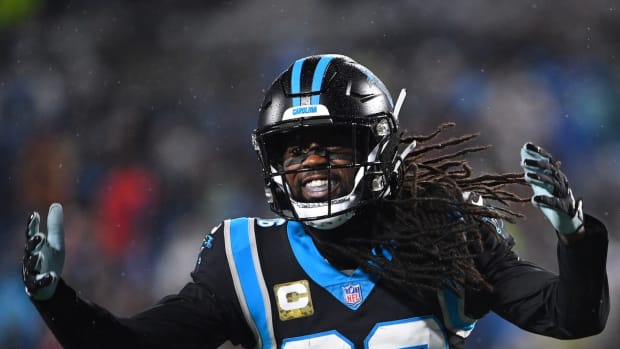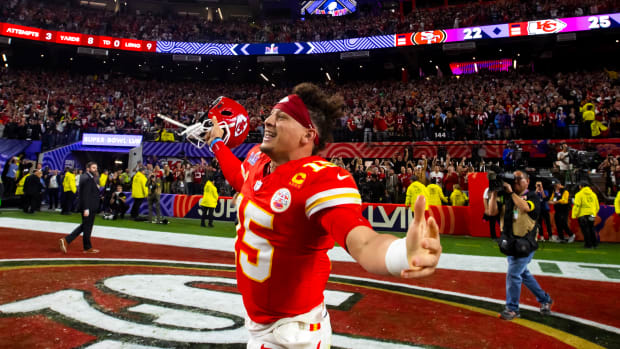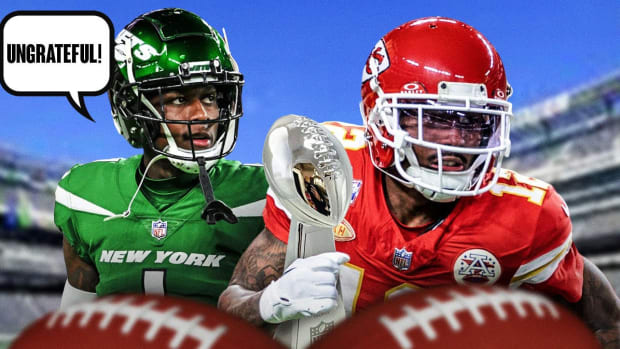Super Bowl Preview: For the Patriots to Win, They Should Follow the Lions’ Lead
In early December, the Rams got demolished on a Sunday night by a stingy Chicago defense and then lost the following week (again in prime time) to Philadelphia. The mini-slump was ugly, and fans doubted they’d see this team in Atlanta come February. Football people did too, given that the slump actually began the week before the Chicago loss, in L.A.’s nondescript victory at Detroit.
From afar, it looked like a comfortable win—30-16 on the road. But 14 of the Rams’ points came late in the game on drives with favorable field position and on somewhat fluky runs by Todd Gurley (a 13-yard touchdown where the Rams’ run design gouged the Lions for taking the unusual step of playing man coverage on first-and-10, and a 36-yard Gurley scamper on the one and only instance where Detroit’s base run D broke down). But midway through the fourth quarter that day, the Rams led just 16-13, having looked nothing like themselves. They’d been out-schemed and out-executed for much of the game. As Rams veteran O-line coach Aaron Kromer put it at Media Night, “I’ll be honest, that game really helped us grow, because it allowed us to notice some deficiencies we had.”
That Lions defense, of course, was headed by Matt Patricia, who is one year removed from being New England’s defensive coordinator and runs the same system that Bill Belichick continues to run. This Week 13 Lions-Rams film is undoubtedly what Belichick and Sean McVay studied closest when building their Super Bowl XLIII game plans.
ROSENBERG: Remember Deflategate? Looking back, it’s now just a blip on Tom Brady’s remarkable career
So what did Patricia’s Lions do to McVay’s Rams that day? First, we must understand each side’s schematic foundation. McVay’s Rams are an outside zone running team (think the ’90s Broncos) with a play-action passing game that derives from these runs. Stellar outside zone blocking from L.A.’s stalwart offensive line is key. Removing that outside zone blocking from the Rams offense would be like removing Mick Jagger from the Rolling Stones. The band might still exist … but not really. Outside zone action is the backbone of L.A.’s run game and pass game.
To propagate a deceptive offense, where all of the outside zone plays start out looking the same, only for some to become runs and others play-action passes, the Rams predominantly play with three wide receivers, aligning them tight and inside, perfectly positioned to run-block or run crossing routes. The run plays ideally will stretch to the perimeter, and the pass plays will feature in-breaking routes.
The Patriots (playing the role of the Lions in this exercise) are a single-high man defense, meaning they play man-to-man coverage, with one safety (Duron Harmon) in deep centerfield and the other in different locations depending on the call. To stop the run, they change up their defensive fronts from snap to snap but always set the edge with their widest defender to prevent runners like Todd Gurley from getting outside. Aside from blitzing their middle linebacker—which the Patriots like to do against teams like the Rams that run outside zone from three-receiver sets—the defense’s focus is mostly on plugging gaps rather than penetrating through them. That’s why New England’s D-line features so many players with great size but only modest athleticism.
JONES: For the Rams’ Dante Fowler, a midseason trade and a career rebirth
So these are the profiles of McVay’s offense and Belichick’s defense. What the Lions did in that Sunday night game was tweak their profile to force the Rams out of theirs. Instead of playing all single-high man-to-man looks, the Lions, especially on first down, showed a “quarters coverage” shell, meaning both safeties and both outside corners were in a matchup zone, each responsible for one-quarter of the field. Safeties in Cover 4 align with less depth than in other zone looks. The Lions safeties were about 10 yards off the ball—just far enough back for McVay to have QB Jared Goff check into a run play, but still close enough to disrupt any of the Rams’ staple in-breaking routes, should McVay stick with a pass.
The catch was that with the Belichick-style scheme committing to an edge-setter, McVay was not always checking to the outside zone runs, which are difficult to execute against a firmly set edge. “If they’re setting the edge, you’re not going to get outside very often,” says Kromer. Instead, McVay dialed up man-blocking runs, with pulling guards and, especially on that day, trap-blockers. They were smart designs that generated good gains, but they were out of context for the Rams, which suddenly separated the run game from the pass game. This ate into many of the outside zone play-action passes, which Goff, one of football’s best timing and rhythm quarterbacks, relies on. When you take Goff out of the outside zone timing and rhythm and ask him to run individual dropback plays again and again, with one play not building off the other, he becomes a less comfortable field-reader and somewhat inconsistent thrower. Goff never looked settled against the Lions, including when he threw a bad interception and lost a sack-fumble—both turnovers of which came against that unexpected Lions’ “quarters coverage.”
BREER: How the Patriots and Rams defined the NFL in the 2018 season
The Lions had ventured well outside their usual schematic identity that day; they’d run very little “quarters coverage” during the season. Belichick’s Patriots, of course, are famous for venturing outside their schematic identity—especially in Super Bowls, with an extra week to prepare. The 2018 Patriots have played few snaps of “quarters coverage,” but with so many veteran defensive backs, including First Team All-Pro corner Stephon Gilmore, who played “quarters” a lot under Rex Ryan in Buffalo, it’s an achievable change. Detailed “quarters coverage” can take years to master, so expect the Patriots, like the Lions in Week 13, to be basic with it. “There are a lot of ins and outs to coverages—it can be hard to pick up in a week or two,” says Patriots cornerbacks coach Josh Boyer. But all they need to do is show “quarters coverage” and force the Rams to check into arrhythmic plays.
This won’t happen every snap. The Patriots will still play plenty of their staple man-to-man. The Rams, who understand that Belichick knows every detail of what Patricia did in Week 13, will have installed a few new “quarters coverage” beaters. And their regular system, with receivers aligning tight together to intersect routes and run crossers, naturally exploits many man coverages.
MORNING HUDDLE: Super Bowl media night—as ridiculous as ever, but still some takeaways
The key is the Patriots simply changing from snap to snap and making some of their looks blurry, if not outright disguised. You don’t need to beat the Rams snap after snap, you just need to make them off-kilter enough that they’re not beating you snap after snap. The Rams don’t kill you when they’re jumping from one play to another, even if they’re mostly good plays. The Rams kill you when they’re gliding through a series of related plays.
The Patriots, by changing their run fronts, setting the edge and showing “quarters coverage” can control this game’s flow. They’re more talented on defense than Detroit, and you can bet that, with Tom Brady, they won’t have just 13 points midway through the fourth quarter. This is a tough matchup for the Rams.
Question or comment? Email us at talkback@themmqb.com.




































